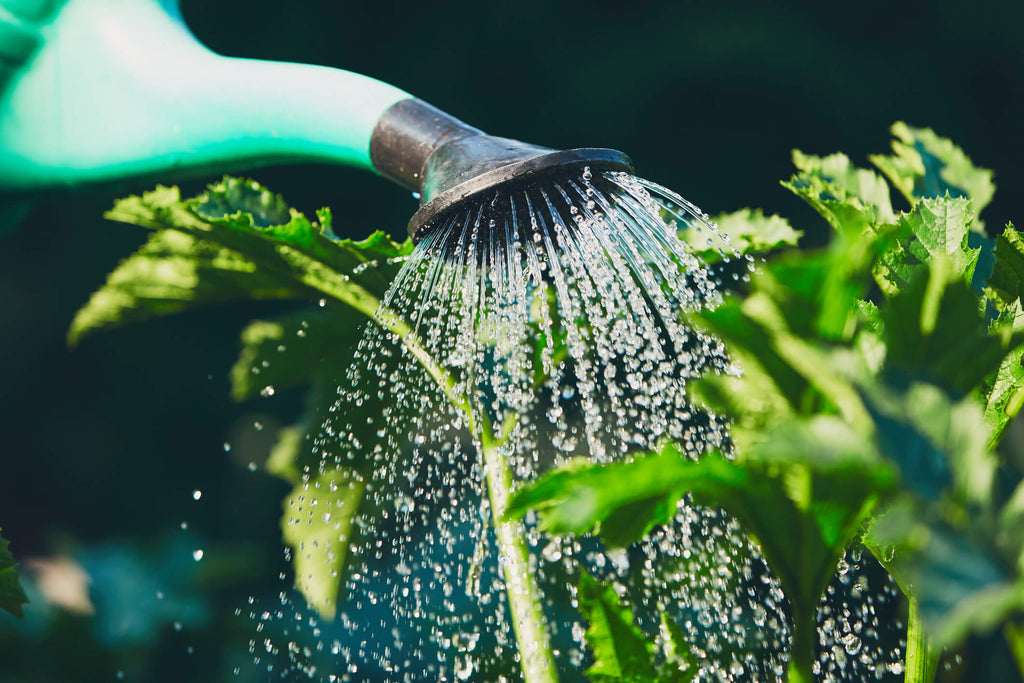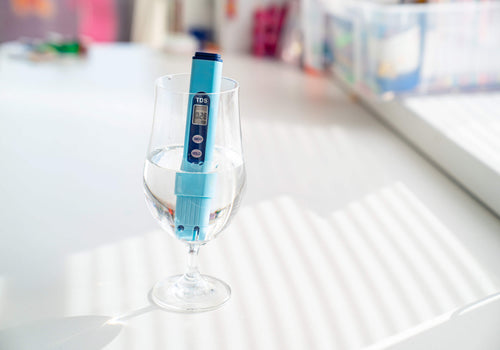Water is considered a universal solvent because of its ability to dissolve and absorb molecules from various substances. The number of dissolved particles in a volume of water is called the total dissolved solids (TDS) level. Understanding your water’s TDS level and which total dissolved solids are present paints a picture of your overall water quality. In this article, you can learn about the different types of total dissolved solids, how to measure them, and how to reduce the TDS levels in your water.
Table of Contents
What is TDS in water?What is the best TDS level for drinking water?What is a TDS meter?Why should you measure total dissolved solids?Health effects of high TDS in drinking waterIs low TDS water harmful?Best TDS levels for plantsHow to reduce TDS in waterWhat is TDS in water?
Total dissolved solids (TDS) are the amount of organic and inorganic materials, such as metals, minerals, salts, and ions, dissolved in a particular volume of water. TDS are essentially a measure of anything dissolved in water that is not an H2O molecule. When water encounters soluble material, particles of the material are absorbed into the water, creating total dissolved solids. TDS in water can come from just about anywhere, including natural water springs, chemicals used to treat the municipal water supply, runoff from roads and yards, and even from your home plumbing system.
Types of total dissolved solids
The following list details common total dissolved solids that may be present in your water.
- Calcium
- Chloride
- Magnesium
- Potassium
- Zinc
- Aluminum
- Copper
- Lead
- Arsenic
- Iron
- Chlorine
- Sodium
- Fluoride
- Bicarbonates
- Sulfates
- Pesticides
- Herbicides
Where do TDS come from?
Total dissolved solids come from many sources, both natural and man-made. Natural sources of TDS include springs, lakes, rivers, plants, and soil. For example, when water flows underground in a natural spring, it absorbs minerals, such as calcium, magnesium, and potassium, from rocks.
On the other hand, effects of human activity can also produce total dissolved solids in water. Pesticides and herbicides may contaminate water from agricultural runoff, lead may originate from old plumbing pipes, and chlorine may come from water treatment plants. TDS are even purposefully added to water in the form of mineral additives.
What is the best TDS level for drinking water?
According to the EPA secondary drinking water regulations, 500 ppm is the recommended maximum amount of TDS for your drinking water. Any measurement higher than 1000 ppm is an unsafe level of TDS. If the level exceeds 2000 ppm, then a filtration system may be unable to properly filter TDS.
What is a TDS meter?
Testing your water using a TDS meter is the simplest way to measure for total dissolved solids. For example, if a TDS meter says 100 ppm, that means that from one million particles, 100 are dissolved ions. This would be considered a low TDS level. However, a TDS meter does not indicate what types of TDS are present, which is ultimately the most important information to know regarding your water quality. A home water test kit or a lab water analysis are recommended to reveal exactly what types of TDS are in your water. Also, your water supplier is required to test and maintain reports regarding water quality and will provide them upon request.
Learn More: Should I test my water's TDS? | Lab water tests vs at-home test kits
TDS Water Chart
| <50-250 ppm | Low: Lacking minerals, such as calcium, magnesium, and zinc. |
| 300-500 ppm | Ideal: This level is the sweet spot for TDS in drinking water. The water most likely contains minerals and does not taste flat. |
| 600-900 ppm | Not great: Consider a reverse osmosis system to filter TDS. |
| 1000-2000 ppm | Bad: It is not recommended to drink water at this TDS level. |
| >2000 | Unacceptable: A TDS level above 2000 ppm is unsafe and household filters can not properly filter this level of contamination. |
How to measure TDS rejection rate
If you have a reverse osmosis system, you can use the following formula to calculate the percent rejection of TDS and to measure your RO system’s performance.
- Measure the TDS of raw feed water by submerging the tester's probes into a glass of tap water. Record the results.
- Measure the TDS of your RO water by filling a glass with RO water (from RO faucet) and submerging the tester's probes into the water. Record the results.
- Calculate percent rejection using the following formula:

Example: Tap TDS = 260 ppm RO TDS = 20 ppm Rejection = [(260 - 20) / 260] x 100 = [240/260] x 100 ≈ (.923) x 100 = 92.3
Note: If your RO system is new or the membrane has been replaced, do not test the first tank of RO water. The first tank will contain sanitizer and possibly carbon fines from your new filters that will cause a false reading.
Why should you measure total dissolved solids?
Total dissolved solids can affect your water quality, your health, your home plumbing system, and even daily tasks, such as cooking and cleaning. By measuring your water for TDS, you can better understand your water quality and how it affects your everyday life, allowing you to make an informed decision to solve your water quality problem and install the most effective filtration system for your home.
1. Taste and smell
Tap water with a high concentration of total dissolved solids (TDS) can have a bitter taste and unpleasant smell. The higher the concentration of total dissolved solids, the more bitter your water will taste. A reverse osmosis system and a ceramic water filter are both recommended to improve the taste and smell of bitter tap water.
Learn more: What is a reverse osmosis system? | What is a ceramic filter?
2. Health
High TDS water is not necessarily unhealthy to drink, but certain substances, such as lead and copper, are health hazards. For example, lead exposure can cause brain and nervous system damage, and high levels of copper exposure can cause nausea. A reverse osmosis system or a water distiller are recommended to filter heavy metals.
Learn more: How to remove lead from water
3. Filter maintenance
Water filtration systems are a great solution to reduce total dissolved solids but are subject to normal wear and tear. Routine testing for TDS can provide assurance that your filter system is working properly and can alert you when maintenance is required.
4. Plumbing and appliances
Water that contains high levels of dissolved calcium and magnesium is hard water and can result in high TDS levels. When calcium and magnesium salts dissolve, they collect in pipes and form scale buildup, which can result in costly pipe replacements and shorten the lives of your appliances. A water softener is recommended to filter calcium and magnesium to prevent scale buildup.
Learn More: What is a water softener and how does it work?
5. Cooking
Though not detrimental to your health at levels below 1000 ppm, cooking with elevated TDS water can change the taste of food. For example, if your water has high levels of chlorine, you may find that your pasta absorbs an unpleasant taste from the boiling water. A carbon filter is an effective choice to remove chlorine from water.
Learn More: Activated carbon filters 101
6. Cleaning
If your dishes have water spots no matter how well you clean them, your clothes fade in the wash, and you have buildup in your sinks, your cleaning woes may be caused by high levels of total dissolved solids. A water softener or other filtration system could decrease the TDS level and make cleaning much more efficient.
Health effects of high TDS in drinking water
Though an elevated TDS level can affect the taste of your water, it is not usually harmful to human health. However, readings above 500 ppm require further investigation for toxic particles and heavy metals, and readings above 1000 ppm are considered unsafe for human consumption. When thinking about your health, note that the type of dissolved solids in your water is more important than the amount. A home water test kit or lab analysis can help you determine if your water contains any harmful substances like lead or pesticides and herbicides.
Learn more: Lab water tests vs at-home test kits
Is low TDS water harmful?
No, low TDS water is not harmful. A low TDS level actually means you have high-quality water, but it may have a flat taste, as it is devoid of many minerals. If your TDS is low from an RO system, consider incorporating a remineralization postfilter into your system if it is designed to accommodate one.
Best TDS levels for plants
If you are growing plants, vegetables, or flowers through hydroponics, then total dissolved solids play an important role in providing nutrients to your plants. Two substances that often cause high TDS levels are potassium and nitrates, both of which greatly benefit roses. Flowers should have around 1000-1100 ppm, while vegetables should have around 900-1000 ppm. Knowing the types of dissolved solids, however, is important when watering vegetables. If toxic ions are present, they will be absorbed by the plant.
Learn More: What are hydroponics systems and how do they work?

How to reduce TDS in water
Certain water treatment systems are effective methods to reduce or remove TDS from water, especially if the TDS level is 500 ppm or higher. There are many useful filtration systems depending on the type of TDS your water contains, but reverse osmosis systems, water distillers, and deionization are comprehensive systems that can reduce a majority of total dissolved solids.
1. Reverse osmosis
A reverse osmosis (RO) system is one of the most comprehensive filters to remove contaminants. It uses pressure to push unfiltered water through a semipermeable membrane. The membrane has small pores that block contaminants, such as total dissolved solids, but allow clean water to flow through to the other side.
Learn More: What is a reverse osmosis system
2. Water distillation
Distillation is a water treatment method that mimics how water is purified in nature – through evaporation in the atmosphere. Water distillers convert water into steam, eliminating total dissolved solids and other contaminants because they cannot turn into steam as water can. Once the water returns to its liquid form, it is contaminant free.
Learn More: What is distilled water and is it safe to drink?
3. Deionization
Deionization systems remove total dissolved solids through ion exchange, using resins that control the electrical charge of ions. Water ions replace charged ions from total dissolved solids. The water produced is highly pure, so deionization cartridges are often referred to as high purity filters.
If you have any further questions about total dissolved solids or how to improve your water quality, please don’t hesitate to contact us.

I really enjoyed your article and I learned useful information. Thank you.
Is PPM the same as mg/L? What would be the equivalent mg/L to 500 PPM?
The content is useful
Hello Mike,
You can purchase a handheld TDS meter that will provide you with a general idea of the TDS levels present in your water. https://www.freshwatersystems.com/collections/handheld-meters
However, if you are interested in a more thorough breakdown of the contaminants in your water and the levels of the various dissolved solids in your water, you should perform a more in-depth water analysis. This test will have you gather samples of your water and mail them to a certified laboratory. They will then provide you with a complete breakdown of the minerals, metals, and inorganics in your water. We recommended this test: https://www.freshwatersystems.com/products/watercheck-w-pesticide-test-kit
Hopefully this helps!
95006